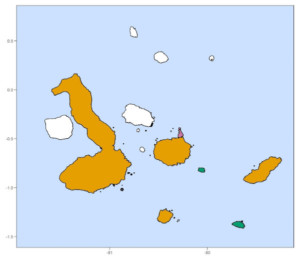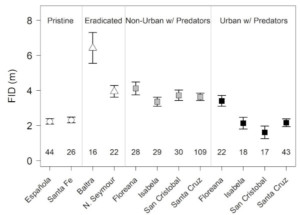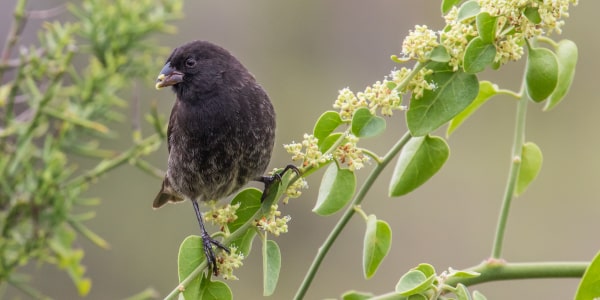LINKED PAPER
Human influences on antipredator behaviour in Darwin’s finches. Gotanda, K.M. 2019. Journal of Animal Ecology. DOI: 10.1111/1365-2656.13127. VIEW
“All of [the terrestrial birds] are often approached sufficiently near to be killed with a switch, and sometimes, as I myself tried, with a cap or a hat.”
-Charles Darwin in The Voyage of the Beagle
The Galapagos Islands are renowned for their biodiversity and large numbers of endemic species, including the Darwin’s finches. When Charles Darwin visited the Galapagos Islands back in 1835, he noted that land birds could be approached near enough to toss a hat over the birds (Darwin 1860)! These and other Galápagos organisms evolved for millions of years in the absence of humans and mammalian predators, and thus developed a remarkable naïveté to humans and their associated animals.
Humans now have a permanent presence on the Galapagos and with that comes a variety of influences. A major, contemporary threat is the introduction of non-native predators (Fritts and Rodda 1998; Low 2002) which is often correlated with extinctions on islands (Clavero and García-Berthou 2005; Sax and Gaines 2008; Clavero et al. 2009). House cats (Felis silvestris catus) are particularly problematic because they can decimate bird populations (Lever 1994; Nogales et al. 2004; Wiedenfeld and Jiménez-Uzcátegui 2008; Loss et al. 2013). Recently, humans have introduced to the Galapagos Islands invasive house cats (Phillips, Wiedenfeld, & Snell, 2012) that opportunistically prey on land bird species, including Darwin’s finches, which poses a major threat to the biodiversity on the islands(Stone et al. 1994; Wiedenfeld and Jiménez-Uzcátegui 2008). The Galapagos National Park has taken extreme conservation measures and successfully eradicated cats and rats on some of the islands (Phillips et al. 2005, 2012; Carrión et al. 2008; Harper and Carrión 2011).
The second human influence is we have established permanent human populations creating urban areas. The increase in urbanization can have a strong effect on ecological and evolutionary processes (Alberti 2015; Alberti et al. 2017; Hendry et al. 2017; Johnson and Munshi-South 2017). Urbanization on the Galápagos Islands has rapidly increased from ~1000 permanent residents to ~25,000 in just 40 years, presently distributed across four towns each on four different islands (UNESCO 2010; Guerrero et al. 2017). We are already seeing the impact of human habitats on behaviour in Darwin’s finches. Urban finches in the largest town on the Galapagos, Puerto Ayora (permanent human population = ~12,000) have shifted their behaviour and now exploit human foods which has changed the finches’ ecological niche (De León et al. 2018).

Figure 1 Map of the Galapagos Islands showing islands that vary in the presence, absence, or eradication of invasive predators. Islands in orange have invasive predators, islands in green are pristine, and islands in purple have had invasive predators eradicated. Islands that have the presence of invasive predators are also the islands with permanent human populations
So, how have Darwin’s finches adapted to these different human influences? I was interested in how the finches might be adapting to the presence, absence, or eradication of invasive mammalian predators, and to urbanization. Specifically, I was interested in their antipredator behaviour. To study this, I focused on flight initiation distance (FID), the distance at which an individual flees an approaching predator, and is a metric of fear.
On islands that have invasive predators, the finches have adapted by increasing their antipredator behaviour. What’s most interesting, though, is that on islands where invasive predators had been successfully eradicated either 8 or 13 years prior to my data collection, the increased behaviour has been maintained. This suggests that the increased antipredator behaviour could be an evolved adaptation. However, it could also be due to other things such as learned behaviour or cultural transmission of the behaviour through the generations. Either way, invasive predators can have a lasting effect on antipredator behaviour in Darwin’s finches.
I also compared antipredator behaviour in urban and non-urban populations of Darwin’s finches on all four islands that have permanent human populations. I found that on the three islands with the three largest human populations, antipredator behaviour was significantly less in urban finches when compared to non-urban finches, likely due to habituation. Furthermore, antipredator behaviour was lower than what I found on islands that were pristine and had no history of any human influences.

Figure 2 Flight initiation distance in finches in relation to the presence, absence, or eradication of invasive predators and between urban and non-urban populations of Darwin’s finches
Thus, my study shows that Darwin’s finches are adapting their antipredator behaviour to different human influences. These findings can help us better understand how the presence and subsequent removal of predators can have lasting effects on antipredator behaviour, and that urbanization, and the likely habituation of Darwin’s finches to the presence of humans and other large stimuli, can strongly counteract any effects of the presence of invasive predators.
Nominate this article for a BOU Science Communication Award.
References & further reading
Alberti, M. 2015. Eco-evolutionary dynamics in an urbanizing planet. Trends in Ecology & Evolution 30: 114–126. VIEW
Alberti, M., Marzluff, J. & Hunt, V.M. 2017. Urban driven phenotypic changes: empirical observations and theoretical implications for eco-evolutionary feedback. Philosophical Transactions of the Royal Society B 372: 20160029. VIEW
Carrión, V., Sevilla, C & Tapia, W. 2008. Management of introduced animals in Galapagos. Galapagos Research 65: 46–48. VIEW
Clavero, M., Brotons, L., Pons, P. & Sol, D. 2009. Prominent role of invasive species in avian biodiversity loss. Biological Conservation 142: 2043–2049. VIEW
Clavero, M., & García-Berthou, E. 2005. Invasive species are a leading cause of animal extinctions. Trends in Ecology & Evolution 20: 110. VIEW
Darwin, C. 1860. The Voyage of the Beagle (Natural Hi.). Doubleday and Co., London, UK.
De León, L.F., Sharpe, D.M.T., Gotanda, K.M., Raeymaekers, J.A.M., Chaves, J.A., Hendry, A.P. & Podos, J. 2018. Urbanization erodes niche segregation in Darwin’s finches. Evolutionary Applications 12: 132–1343. VIEW
Fritts, T.H. & Rodda, G.H. 1998. The role of introduced species in the degradation of island ecosystems: a case history of Guam. Annual Review of Ecology and Systematics 29: 113–140. VIEW
Garget, J. 2019. A decade after the predators have gone, Galapagos Island finches are still being spooked. University of Cambridge. Available at: https://www.cam.ac.uk/research/news/a-decade-after-the-predators-have-gone-galapagos-island-finches-are-still-being-spooked. VIEW
Guerrero, J.G., Castillo, R., Menéndez, J., Nabernegg, M., Naranjo, L. & Paredes, M. 2017. Memoria Estadística Galápagos.
Harper, G.A. & Carrión, V. 2011. Introduced rodents in the Galapagos: colonisation, removal and the future. Pages 63–66 in Veitch, C.R., Clout, M.N. & Towns, D.R., eds. Island Invasives: Eradication and Management. IUCN, Gland, Switerzland. VIEW
Hendry, A.P., Gotanda, K.M. & Svensson, E.I. 2017. Human influences on evolution, and the ecological and societal consequences. Philosophical Transactions of the Royal Society B 372: 20160028. VIEW
Johnson, M.T.J. & Munshi-South, J. 2017. Evolution of life in urban environments. Science 358: eaam8237. VIEW
Lever, C. 1994. Naturalized Animals: The Ecology of Successfully Introduced Species. Poyser Natural History, London.
Loss, S.R., Will, T & Marra, P.P. 2013. The impact of free-ranging domestic cats on wildlife of the United States. Nature Communications 4: 2961. VIEW
Low, T. 2002. Feral Future: The Untold Story of Australia’s Exotic Invaders. University of Chicago Press, Chicago.
Nogales, M., Martín, A., Tershy, B.R., Donlan, C.J., Veitch, D., Puerta, N., Wood, B. & Alonso, J. 2004. A review of feral cat eradication on islands. <e,>Conservation Biology 18: 310–319. VIEW
Phillips, R.B., Cooke, B.D., Campbell, K., Carrion, V., Marquez, C. & Snell, H.L. 2005. Eradicating feral cats to protect Galapagos Land Iguanas: methods and strategies. Pacific Conservation Biology 11: 257–267. VIEW
Phillips, R.B., Wiedenfeld, D.A. & Snell, H.L. 2012. Current status of alien vertebrates in the Galápagos Islands: invasion history, distribution, and potential impacts. Biological Invasions 14: 461–480. VIEW
Sax, D.F. & Gaines, S.D. 2008. Species invasions and extinction: the future of native biodiversity on islands. Proceedings of the National Academy of Sciences 105 (Supplement 1): 11490–11497. VIEW
Stone, P.A., Snell, H.L. & Snell, H.M.. 1994. Behavioral diversity as biological diversity: introduced cats and lava lizard wariness. Conservation Biology 8: 569–573. VIEW
Taylor, M. 2019. Fight or Flight? Galapagos Island Study Reveals Human-induced Fear Behaviors. Laboratory Equipment. Available at: https://www.laboratoryequipment.com/557944-Fight-or-Flight-Galapagos-Island-Study-Reveals-Human-induced-Fear-Behaviors/. VIEW
UNESCO. 2010. Reactive Monitoring Mission Report. VIEW
Wiedenfeld, D.A. & Jiménez-Uzcátegui. 2008. Critical problems for bird conservation in the Galápagos Islands. Cotinga 29: 22–27. VIEW
Yeung, J. 2019. Is fear hereditary? Darwin’s frightened Galapagos finches suggest the answer is yes. CNN, 20 November 2019. Available at: https://edition.cnn.com/2019/11/20/americas/galapagos-finches-predators-intl-hnk-scli-scn/index.html. VIEW
Image credit
Featured image: Small Ground Finch Geospiza fuliginosa © Kiyoko Gotanda




